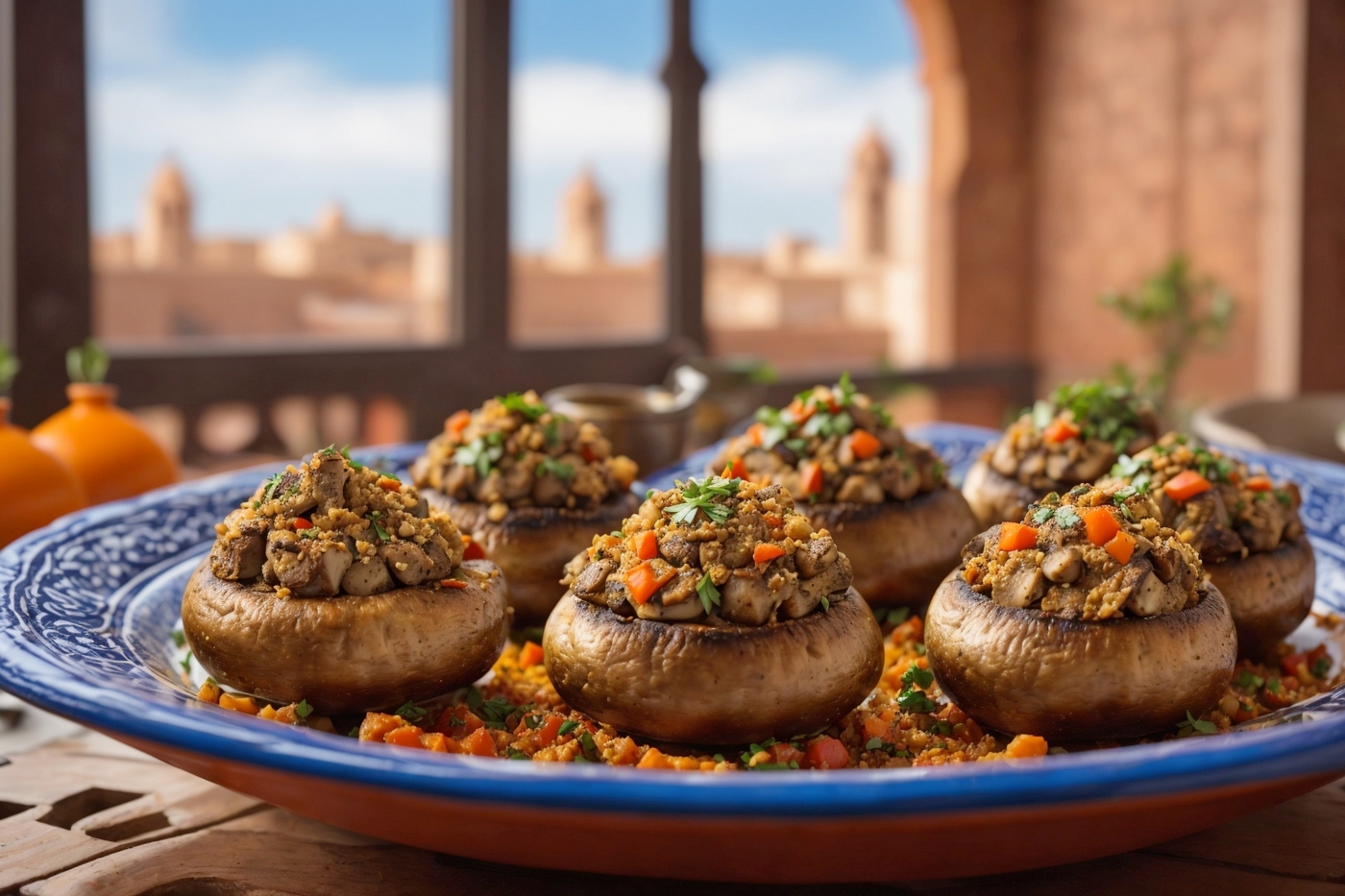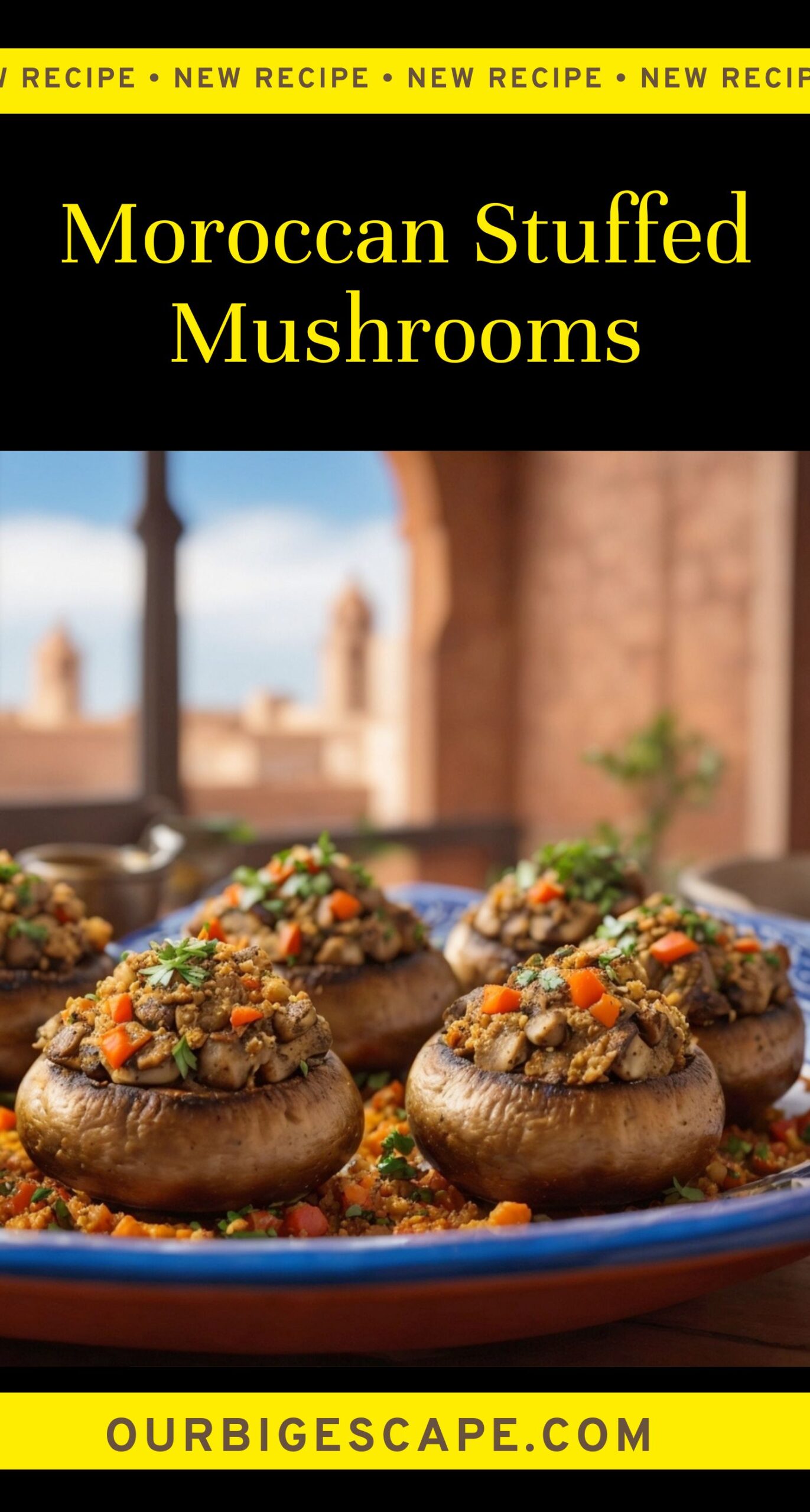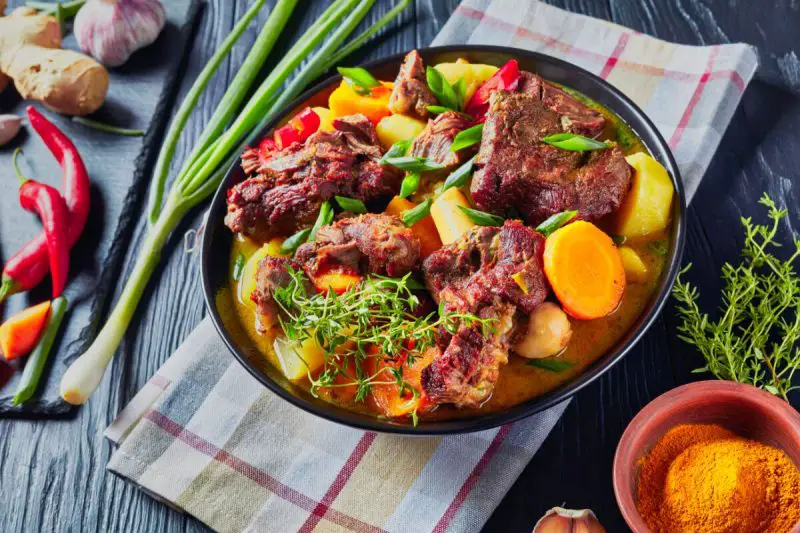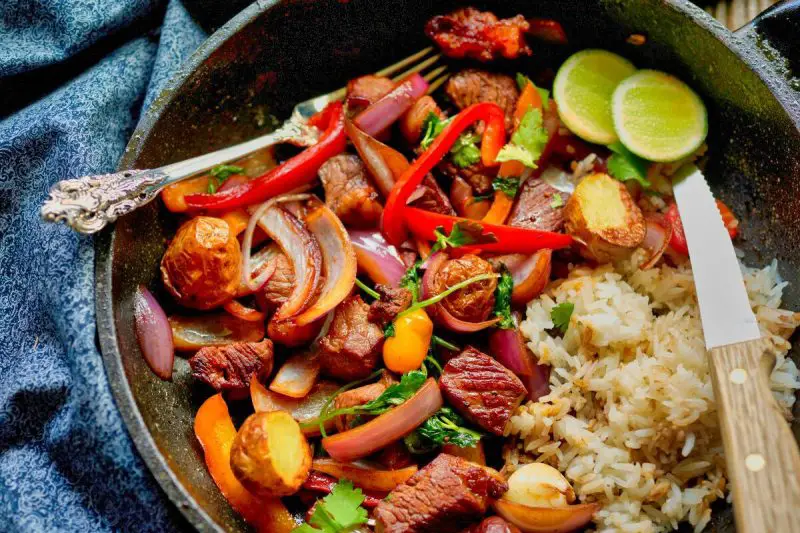Today we want to offer you some information about traditional Moroccan Recipes. Morocco is geographically located in the north-west corner of Africa. The country is slightly larger in area than California, USA and it has three different regions.
Traditional Moroccan Recipes
The northern coast of Morocco along the Mediterranean sea is the most fertile land and rises to heights of about 8,000 feet. Moreover, the Atlas mountains start from the Atlantic coast, southwest, and runs to the Mediterranean Sea on the northeastern side. Last, but not least, the semiarid region is in the east and south region, the Western Sahara, and connects Morocco to the vast Sahara Desert. Morocco, since ancient times, faces problems with desertification which is caused by forces of mother nature such as inadequate rainfall or drought. However, in the northwest region of Morocco agriculture thrives, except when there is a severe drought. Therefore, farmers in Morocco can supply citizens with enough food.
21 Great Traditional Moroccan Recipes
1. Moroccan Stew with Chickpeas & Sweet Potatoes
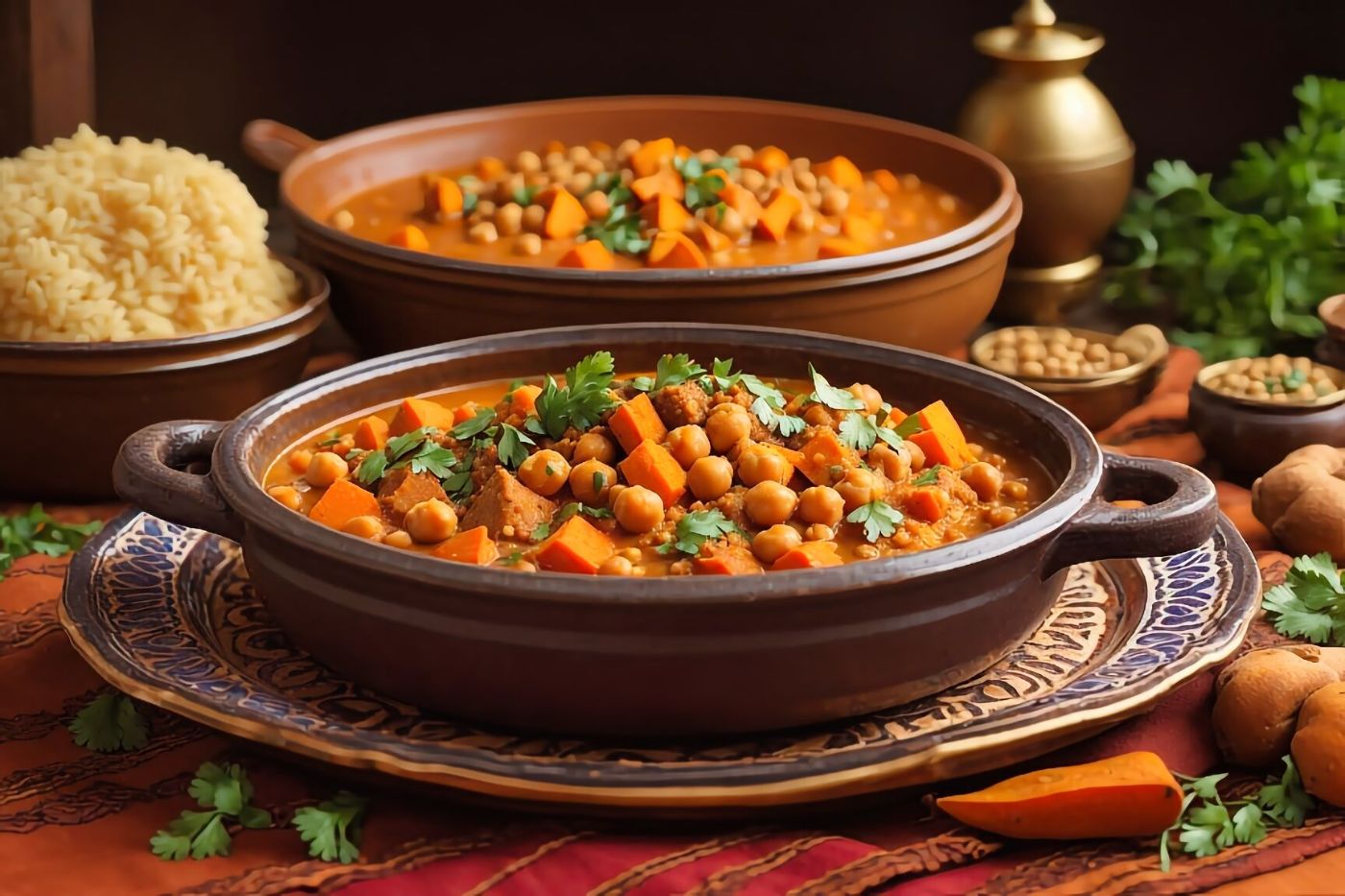
Stew with Chickpeas & Sweet Potatoes is a hearty and comforting Moroccan dish that combines tender chickpeas and sweet potatoes with aromatic spices. The stew is made by simmering chickpeas, sweet potatoes, tomatoes, onions, and a blend of Moroccan spices such as cumin, cinnamon, and ginger. The flavors meld together to create a rich and flavorful dish that is perfect for cold winter days. Serve it with some crusty bread or couscous for a complete and satisfying meal.
2. Stewed Moroccan Beans
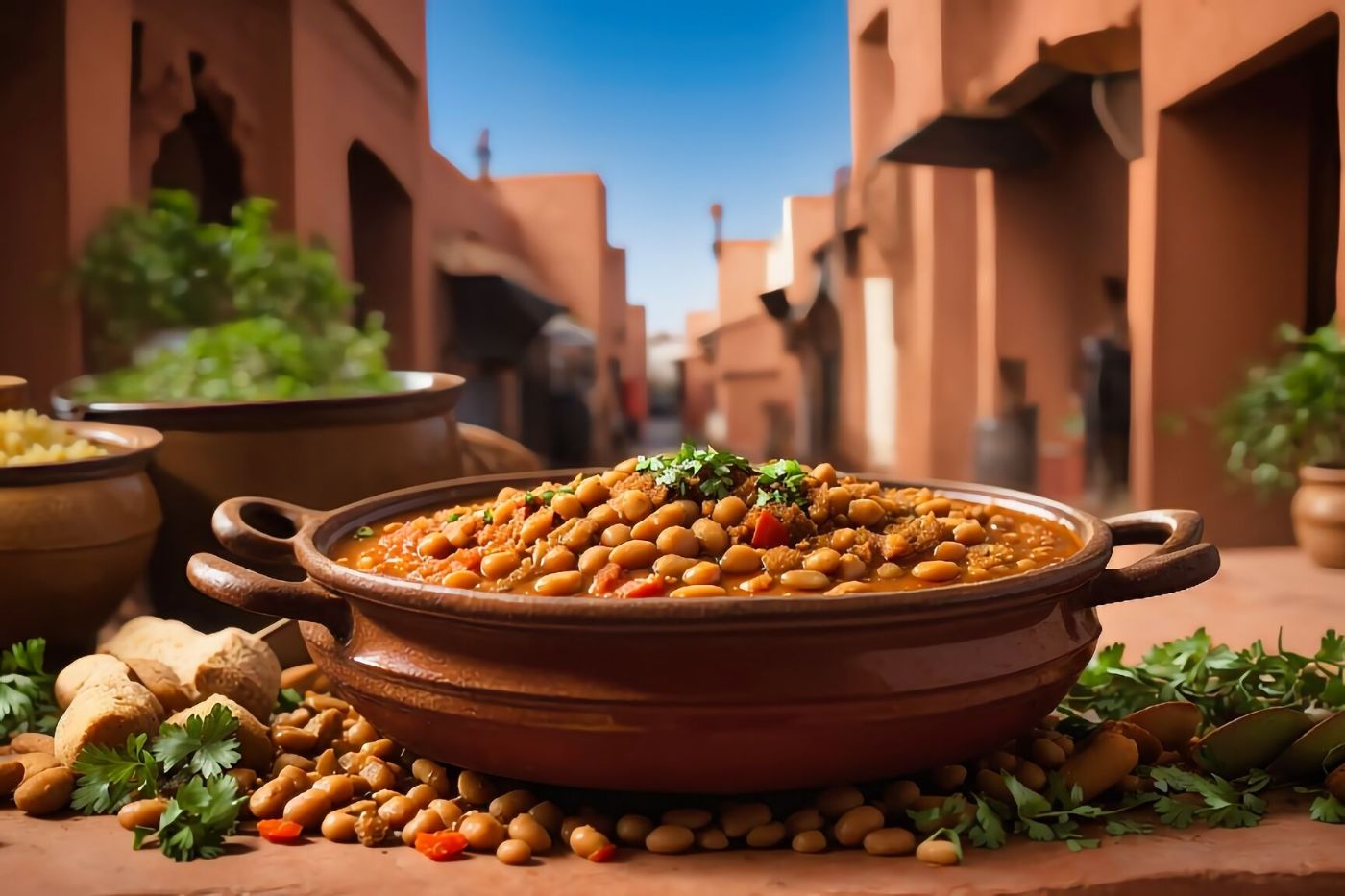
Stewed Moroccan Beans is a delicious and nutritious dish featuring a flavorful blend of beans, vegetables, and aromatic spices. The dish typically includes a variety of beans such as chickpeas, kidney beans, or white beans, along with tomatoes, onions, garlic, and a combination of spices like cumin, paprika, and turmeric. It is simmered until the beans are tender and the flavors are well-developed. This hearty and protein-packed dish can be enjoyed as a main course or served as a side dish with bread or couscous.
3. Moroccan Meatballs
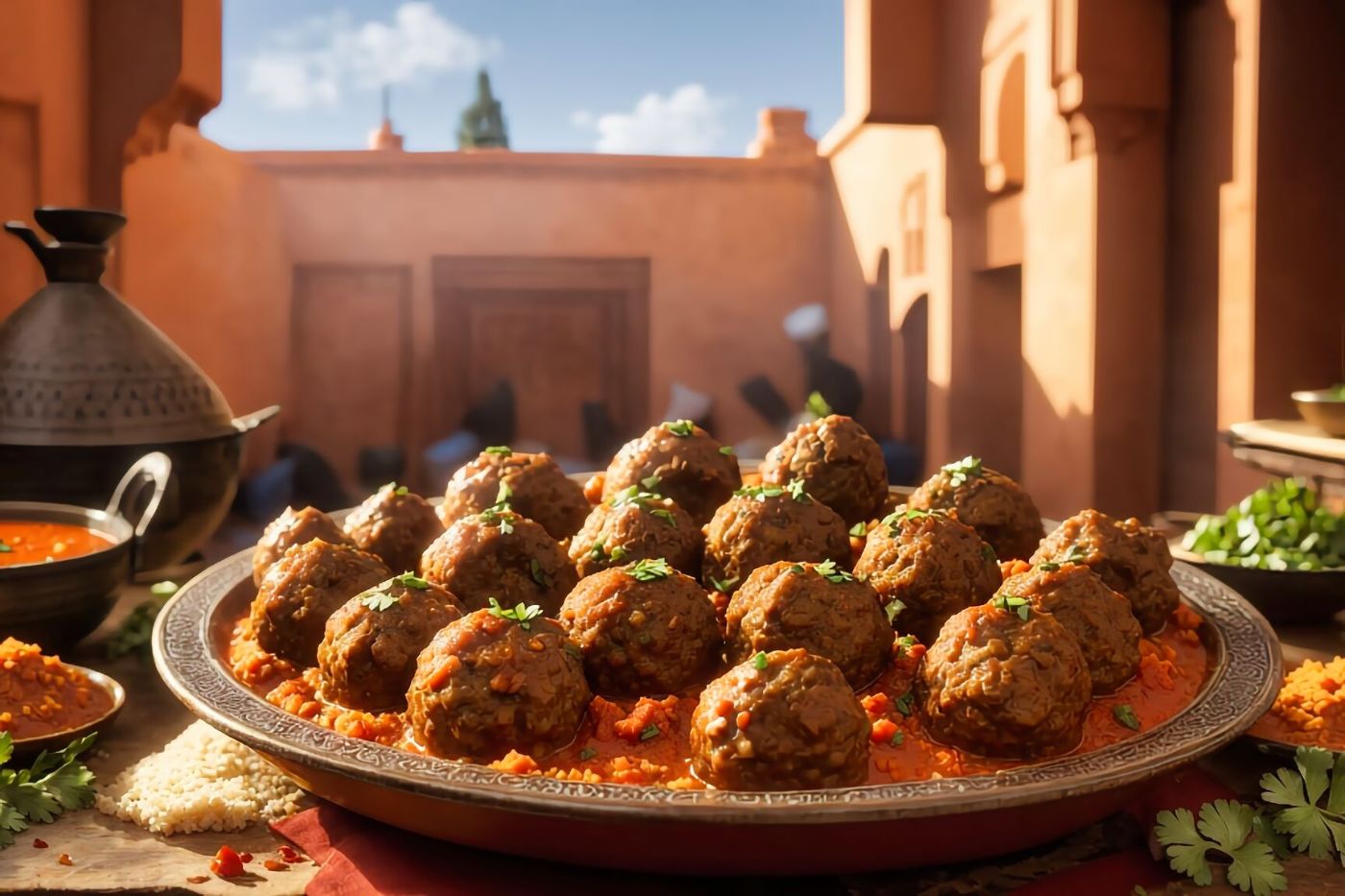
Moroccan Meatballs are a savory and aromatic dish that features tender and flavorful meatballs cooked in a rich and spiced tomato sauce. The meatballs are typically made with ground beef or lamb, mixed with breadcrumbs, herbs, and spices like cumin, paprika, and cinnamon. They are then simmered in a tomato-based sauce with onions, garlic, and Moroccan spices until cooked through and the flavors meld together. This dish is often served with couscous or bread and can be accompanied by a side of vegetables or salad.
4. Moroccan Taktouka Salad
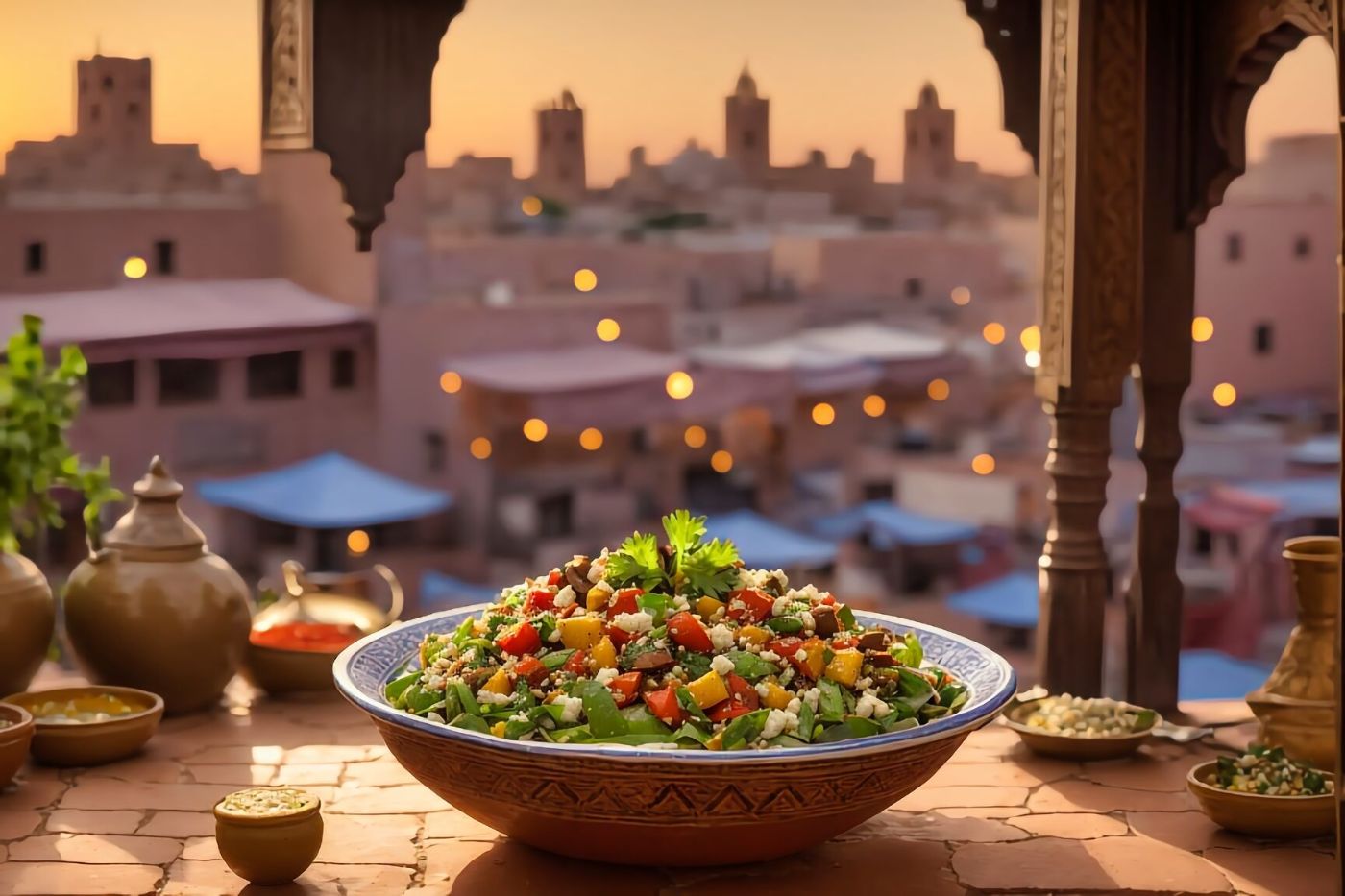
Moroccan Taktouka Salad is a vibrant and zesty salad made with roasted bell peppers, tomatoes, and onions. The vegetables are charred over an open flame to enhance their smoky flavor and then peeled and chopped. They are combined with garlic, spices like cumin and paprika, olive oil, and lemon juice to create a tangy and aromatic dressing. This salad is traditionally served as a side dish or appetizer, and it pairs well with crusty bread or can be used as a topping for grilled meats or sandwiches.
5. Beghrir or Moroccan Pancakes
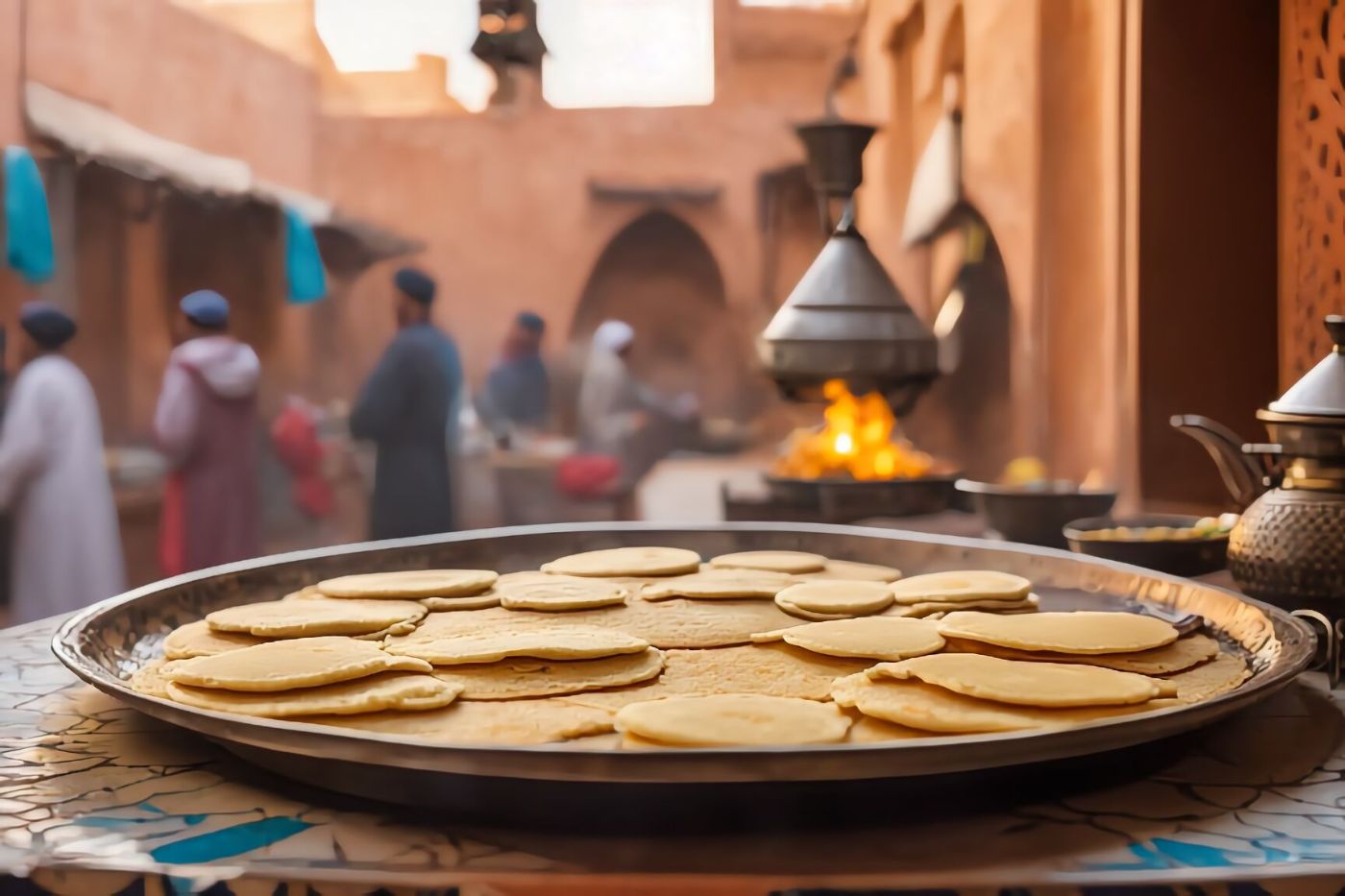
Beghrir, also known as Moroccan Pancakes, are light and fluffy semolina pancakes with a unique texture. The batter is made with semolina flour, all-purpose flour, yeast, and water, which is left to ferment overnight. When cooked on a hot griddle, the pancakes develop small holes on the surface, creating a spongy texture. Beghrir is typically served with melted butter and honey or syrup, and it is a popular breakfast or snack in Moroccan cuisine.
6. Saucy Moroccan-Spiced Lentils
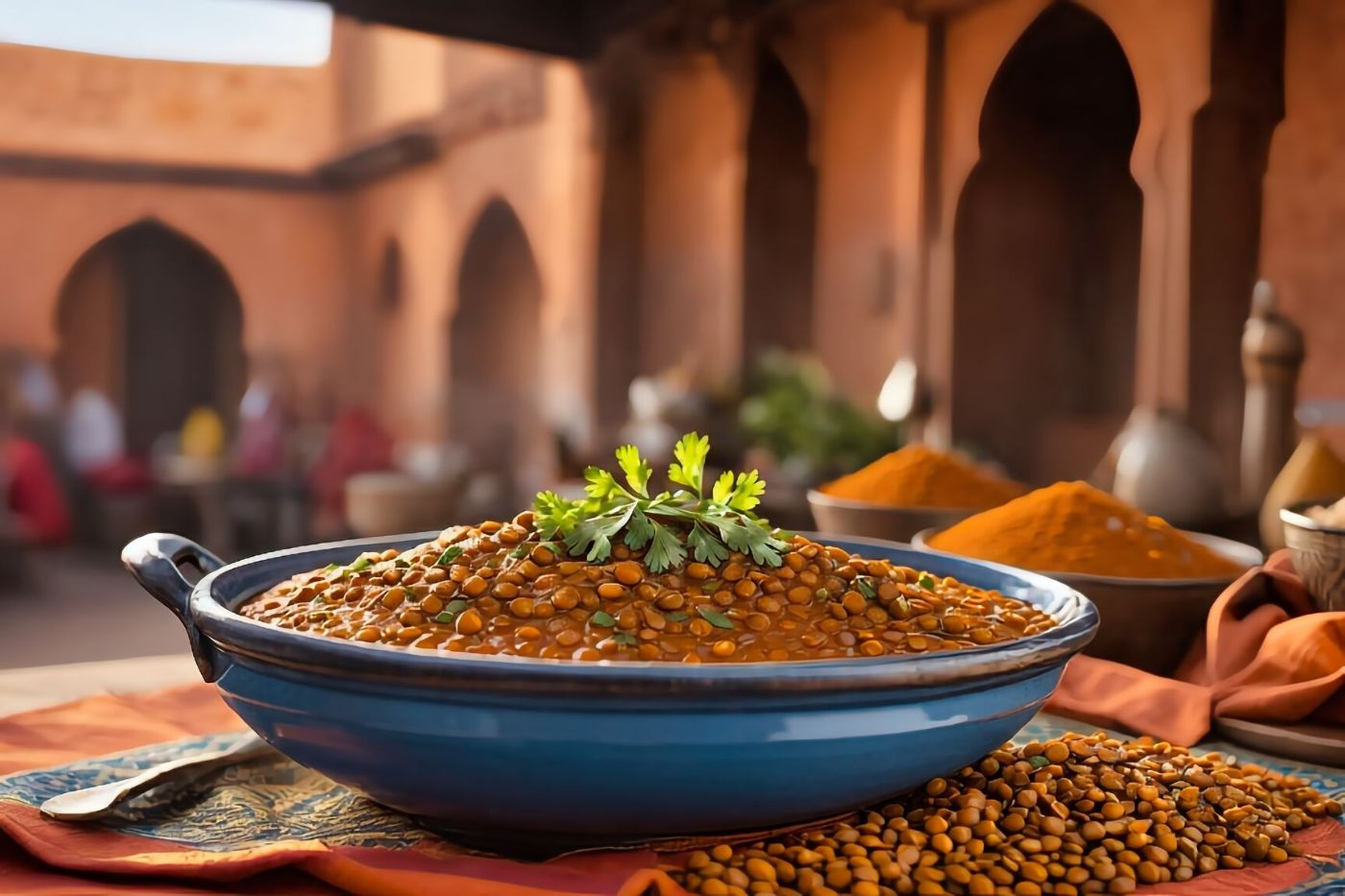
No limits apply to lentils. They make the ideal high-protein, high-fiber snack and may be flavored with almost any flavor. Regarding flavor, I adore spices. This dish reminded me of the flavors of Morocco. Put paprika, turmeric, coriander, and pepper in your mind. Spices like cinnamon, cumin, ginger, paprika, saffron, and turmeric are frequently used in Moroccan cooking. Ras El Hanout is a mixture that is frequently used in Moroccan cooking.
7. Moroccan Lamb Tagine
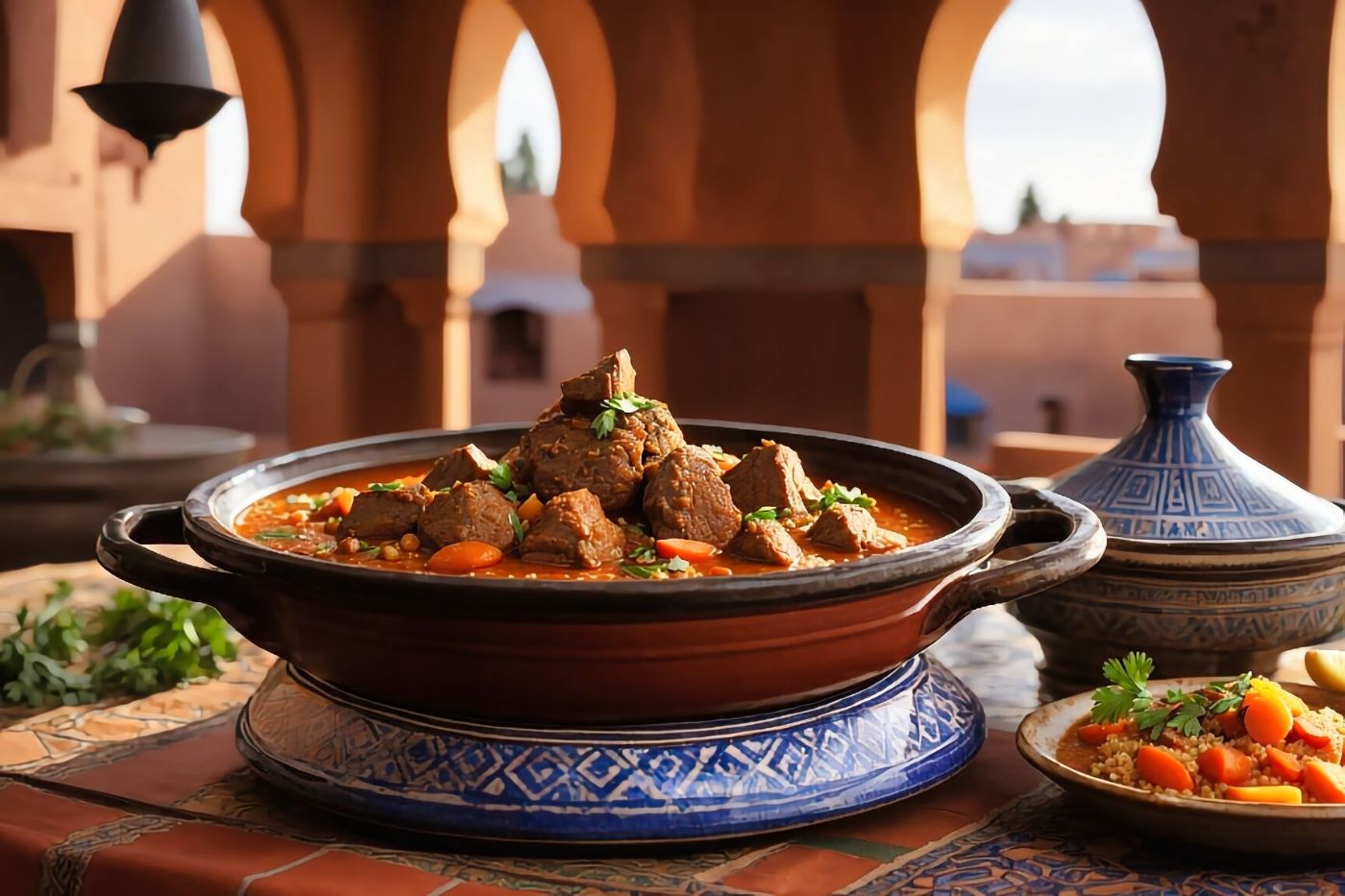
Moroccan Lamb Tagine is a traditional Moroccan dish featuring tender lamb cooked with an array of aromatic spices and flavors. The lamb is marinated in a blend of spices like cumin, coriander, cinnamon, and paprika, then slow-cooked with onions, garlic, and dried fruits like apricots or prunes. The result is a rich and flavorful stew with tender lamb, perfectly balanced with the sweetness of the fruits. This dish is typically served with couscous or crusty bread and is a true taste of Moroccan cuisine.
8. Moroccan Vegetable Stew
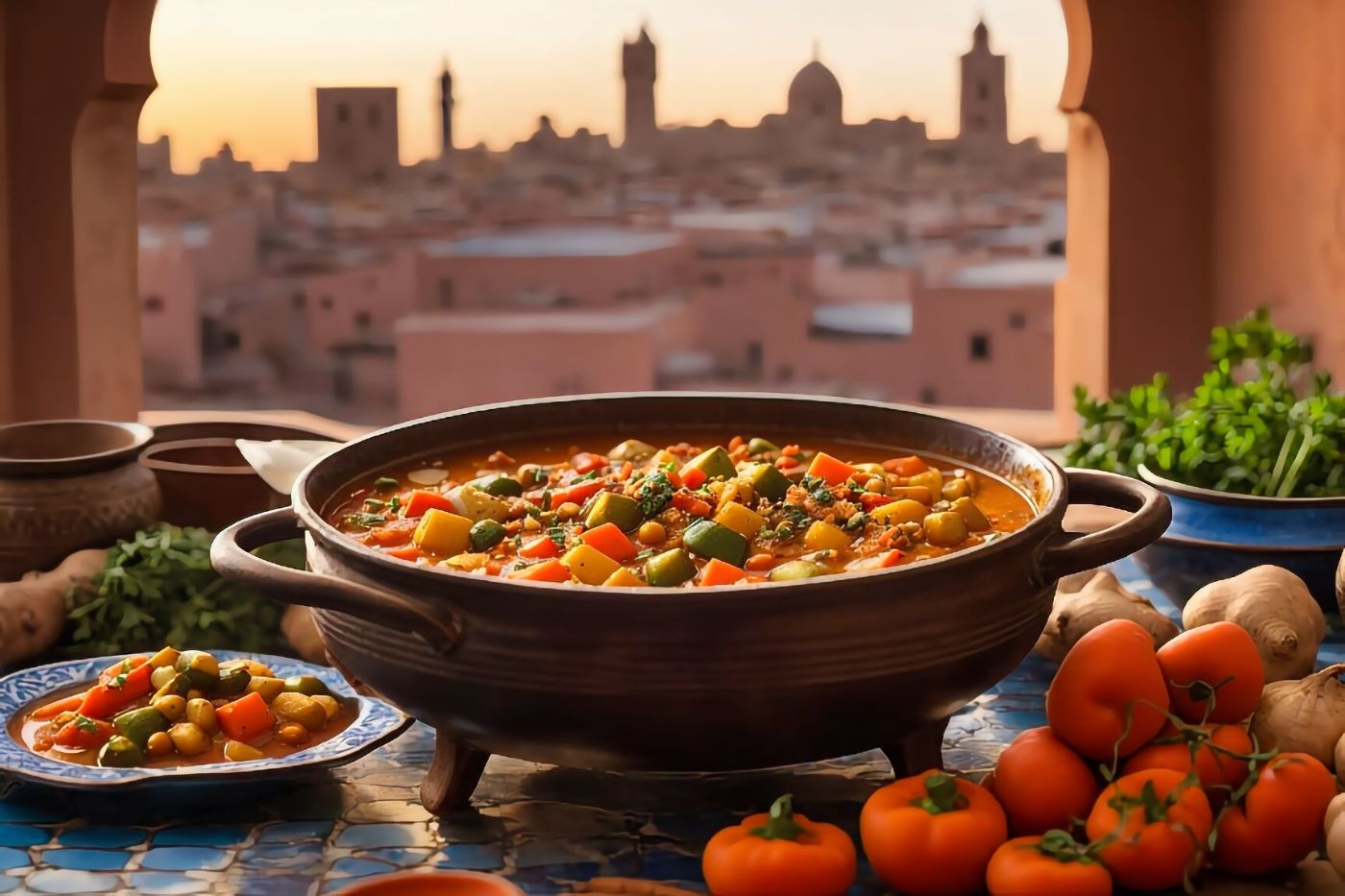
Moroccan Vegetable Stew is a hearty and flavorful dish packed with a variety of vegetables and aromatic spices. It typically features a combination of vegetables like carrots, potatoes, bell peppers, zucchini, and tomatoes, cooked in a fragrant blend of spices such as cumin, turmeric, ginger, and cinnamon. The stew is often enriched with vegetable broth and simmered until the vegetables are tender and the flavors have melded together. It is a comforting and nutritious dish that showcases the vibrant flavors of Moroccan cuisine.
9. Moroccan Meatballs
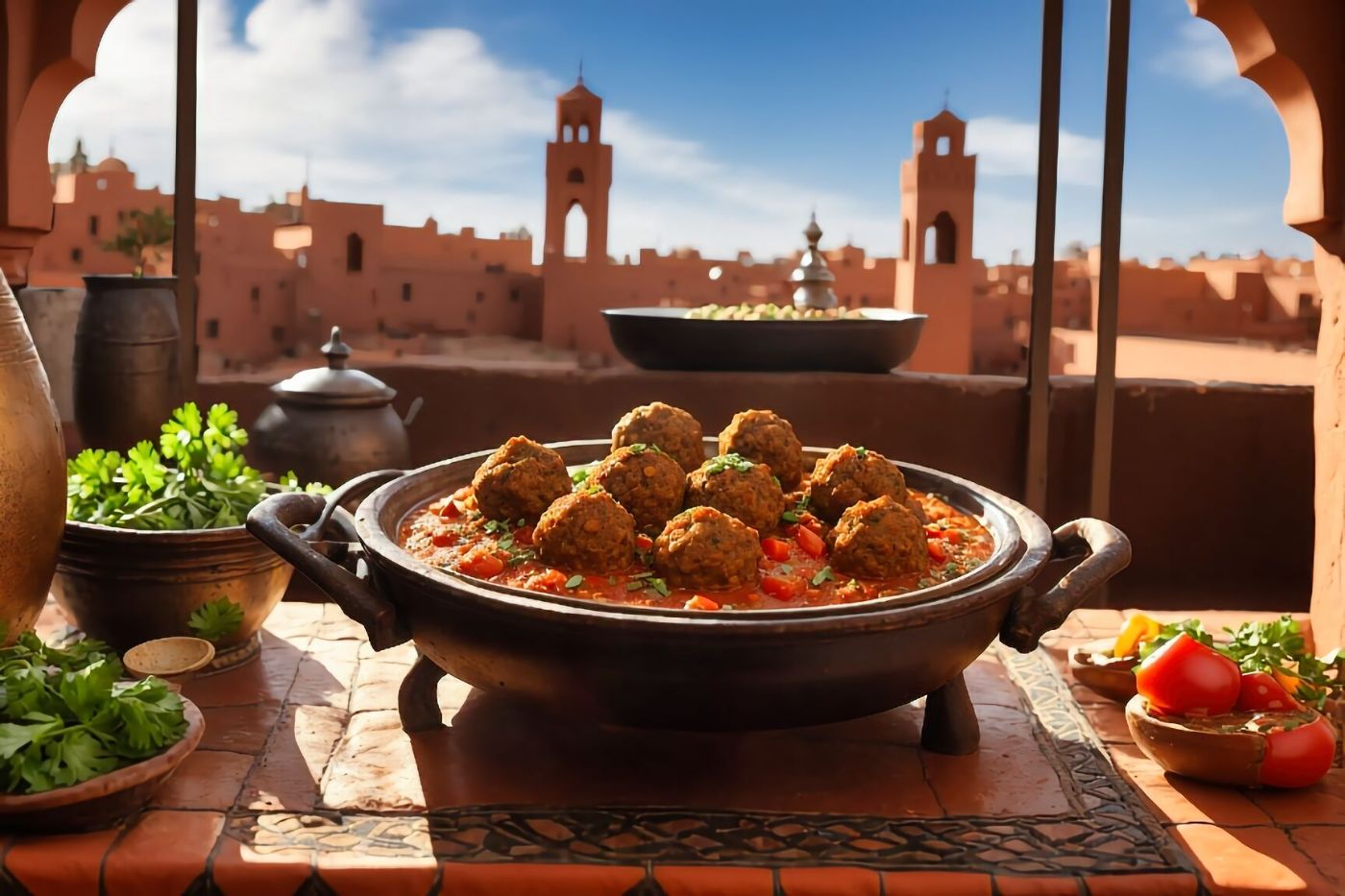
Moroccan Meatballs, or kefta, are a delicious and aromatic dish made with ground meat, typically lamb or beef, mixed with spices and herbs. The meat mixture is seasoned with a combination of spices like cumin, coriander, paprika, and cinnamon, which give the meatballs their distinct Moroccan flavor. They are typically shaped into small balls and then baked, fried, or simmered in a rich tomato-based sauce. Moroccan meatballs are often served with couscous or bread, and they make a flavorful and satisfying meal.
10 Braised Moroccan Chicken and Olives
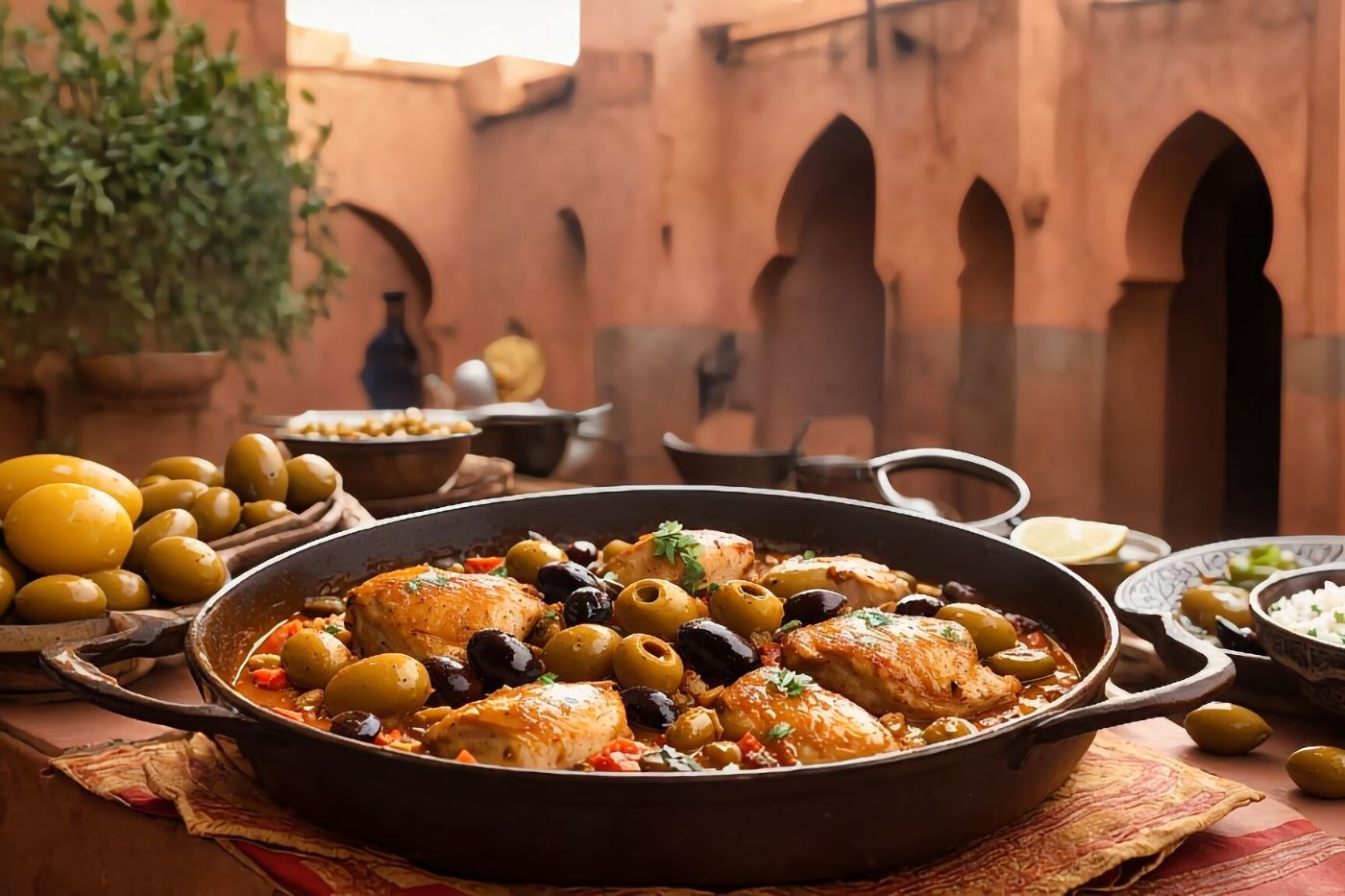
Braised Moroccan Chicken and Olives is a flavorful dish that combines tender chicken with the vibrant flavors of Moroccan cuisine. The chicken is marinated in a fragrant blend of spices like cumin, paprika, ginger, and cinnamon, then braised with onions, garlic, and green olives in a savory tomato-based sauce. The dish is simmered until the chicken is juicy and the flavors have melded together. It is typically served over couscous or with crusty bread, making it a hearty and satisfying meal with a touch of exotic flair.
11. Moroccan Couscous
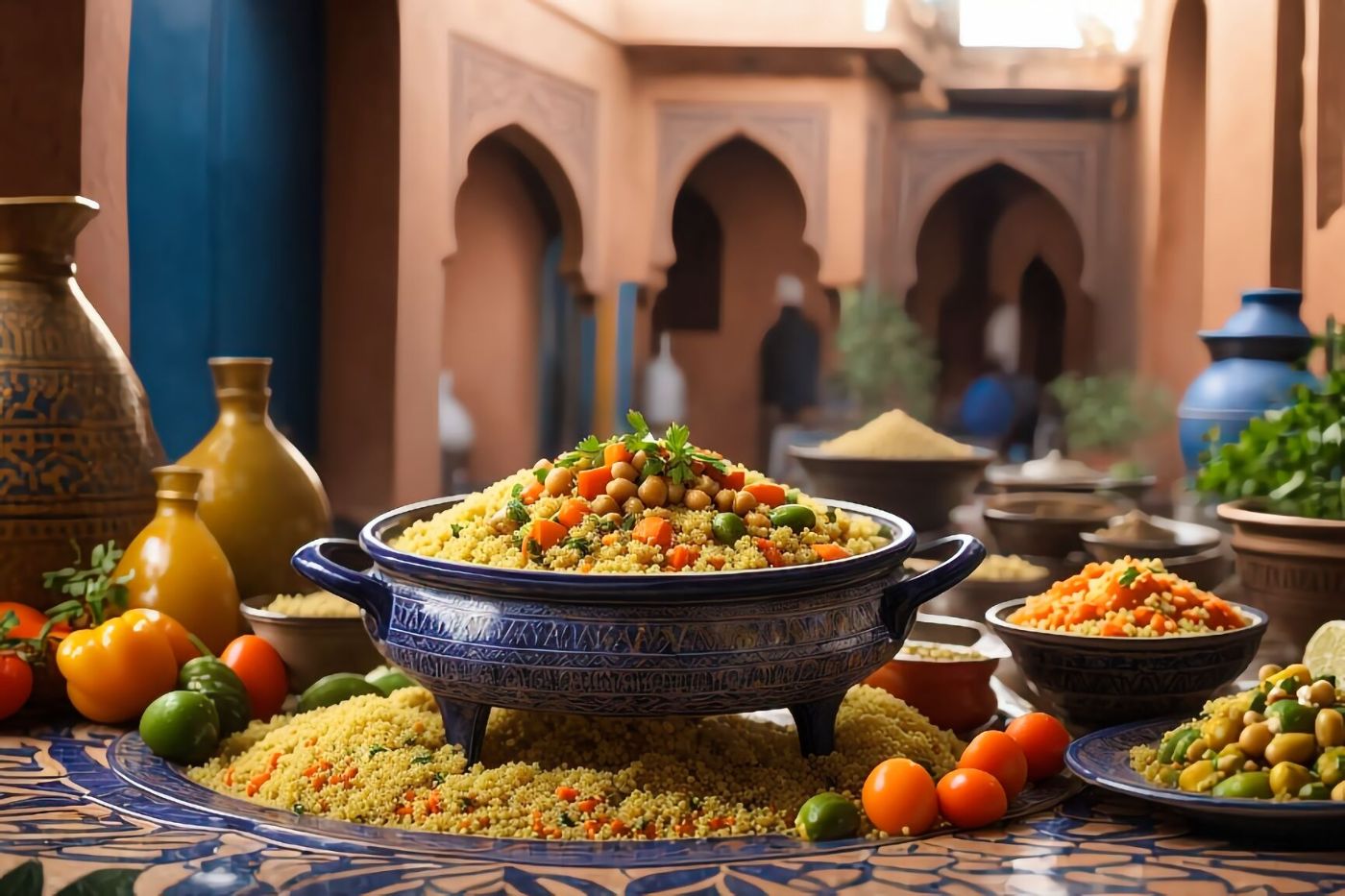
Moroccan Couscous is a traditional dish that showcases the rich flavors and textures of Moroccan cuisine. It features fluffy couscous grains cooked with aromatic spices like cumin, coriander, and turmeric. The couscous is typically accompanied by a colorful assortment of vegetables such as carrots, zucchini, and bell peppers, as well as tender cooked chickpeas. The dish is often garnished with fresh herbs like parsley and mint, and sometimes topped with roasted almonds or raisins for added sweetness and crunch. It is a delicious and satisfying vegetarian option that can be enjoyed as a main course or a side dish.
12. Moroccan Chicken
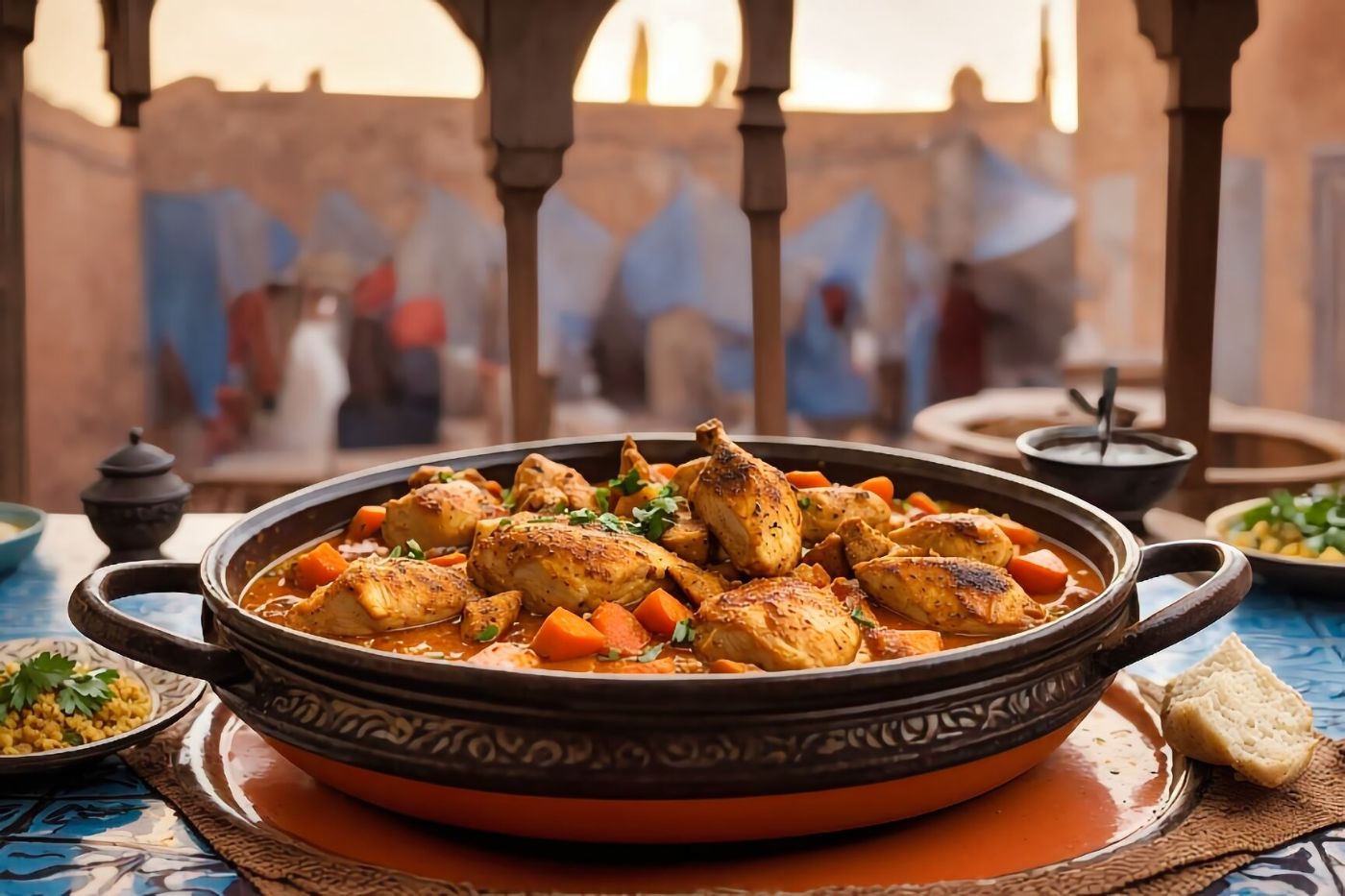
Moroccan Chicken is a flavorful and aromatic dish that showcases the vibrant spices and ingredients of Moroccan cuisine. Tender chicken pieces are marinated in a blend of spices such as cumin, paprika, turmeric, and cinnamon, which infuse the meat with a rich and fragrant flavor. The chicken is then cooked with onions, garlic, and a medley of vegetables like bell peppers and tomatoes. It is typically served with fluffy couscous or crusty bread to soak up the delicious sauce. This dish is a true taste of Morocco, offering a perfect balance of savory and exotic flavors.
13. Moroccan Chicken Tagine
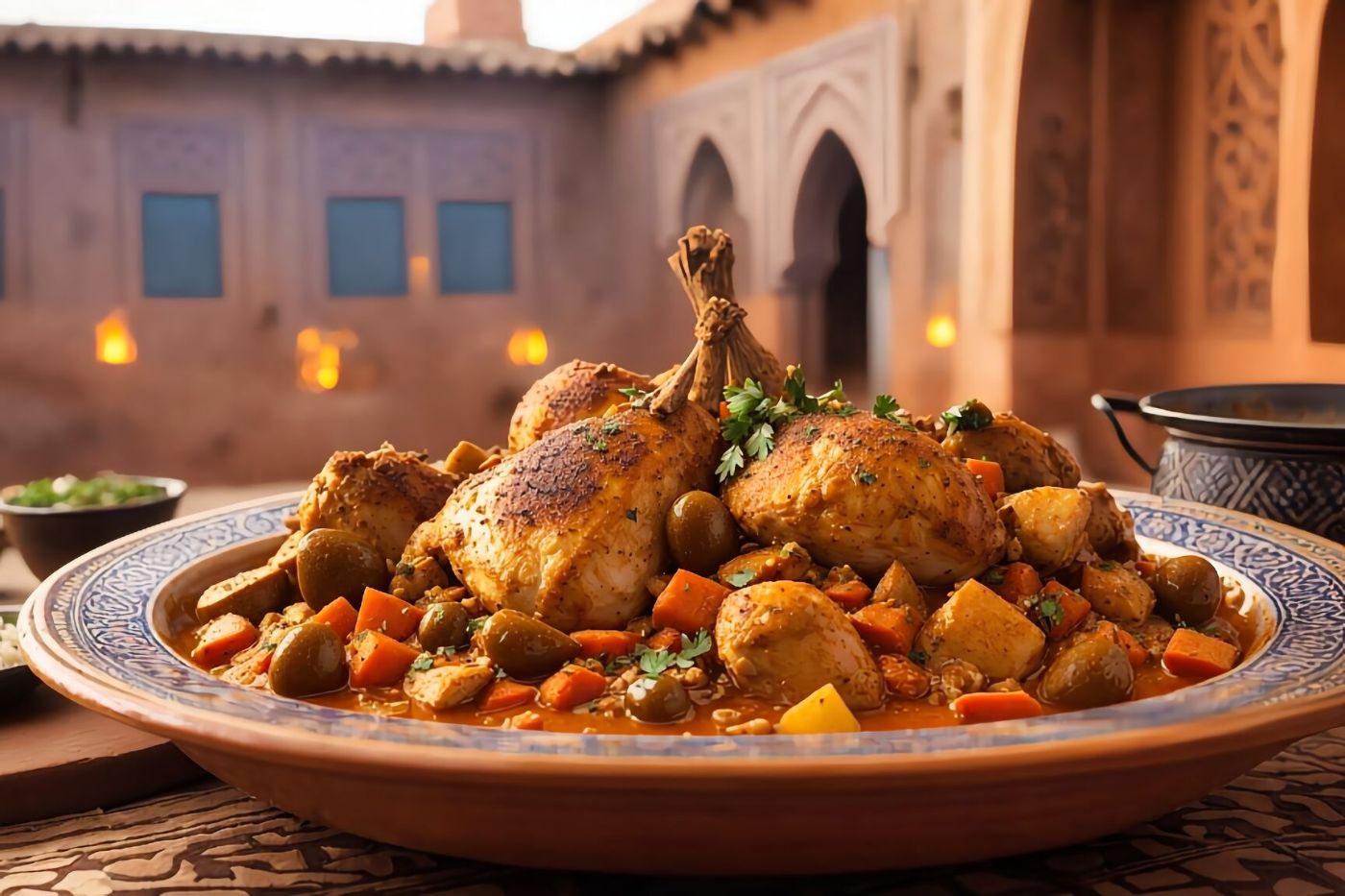
Moroccan Chicken Tagine is a traditional Moroccan dish known for its aromatic spices and tender chicken. The chicken is marinated in a blend of spices like cumin, coriander, ginger, and cinnamon, then cooked slowly in a tagine or a deep, heavy-bottomed pot. It is typically combined with onions, garlic, preserved lemons, olives, and a variety of herbs like cilantro and parsley. The result is a flavorful and fragrant stew-like dish with tender chicken and a rich, savory sauce. It is often served with couscous or crusty bread.
14. Moroccan Rfisa
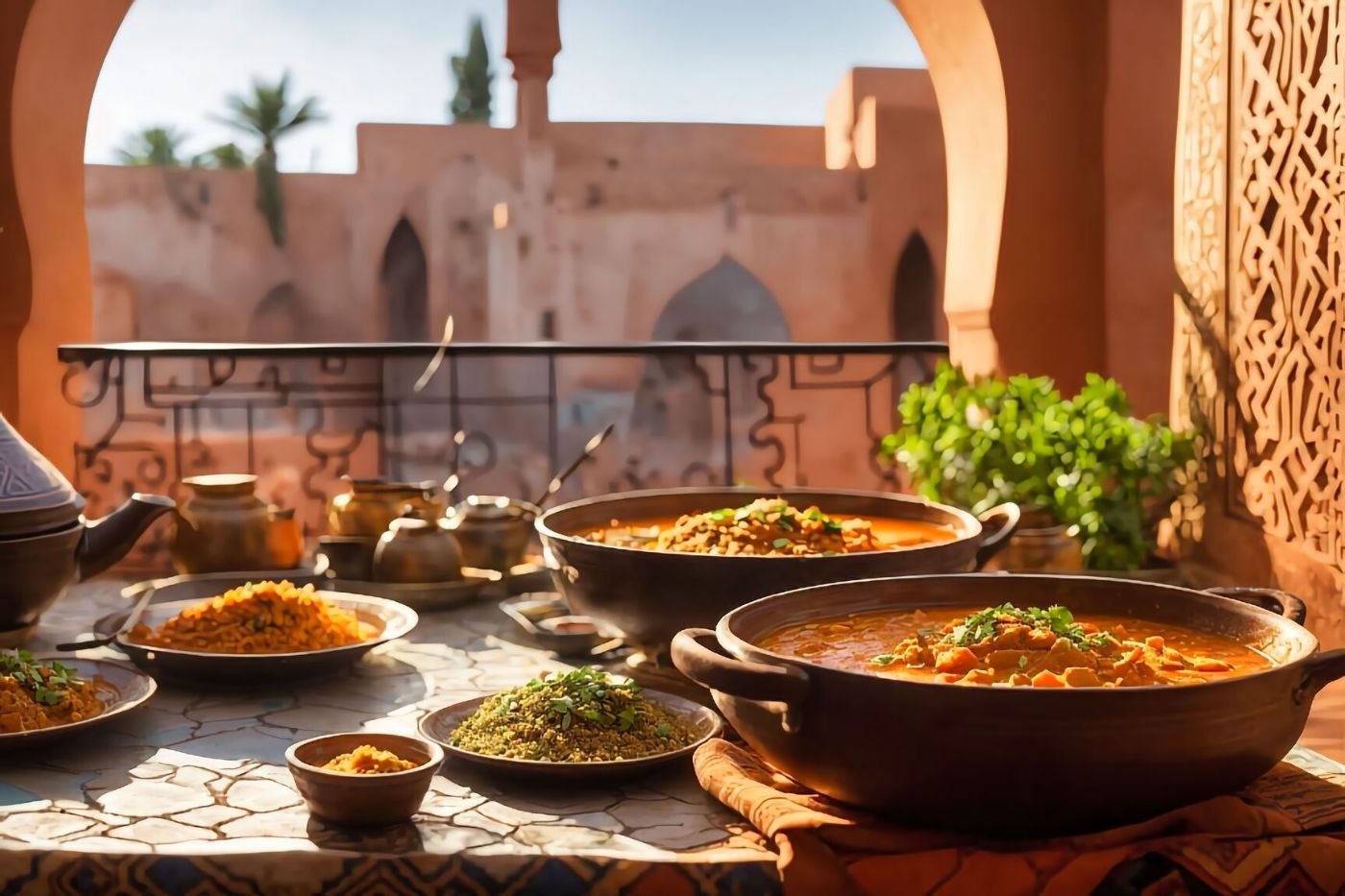
Moroccan Rfisa is a traditional Moroccan dish made with shredded chicken and thin crepes called “msekhen.” The chicken is slow-cooked with aromatic spices and then shredded. The msekhen are soaked in a broth made from the cooking liquid and blended with a sauce made from onions, garlic, and spices. The shredded chicken is layered with the soaked msekhen and topped with the sauce. It is typically served with a sprinkling of cinnamon and powdered sugar. The dish has a unique combination of flavors and textures, with the soft crepes and tender chicken in a savory sauce.
15. Roasted Moroccan-Style Vegetables
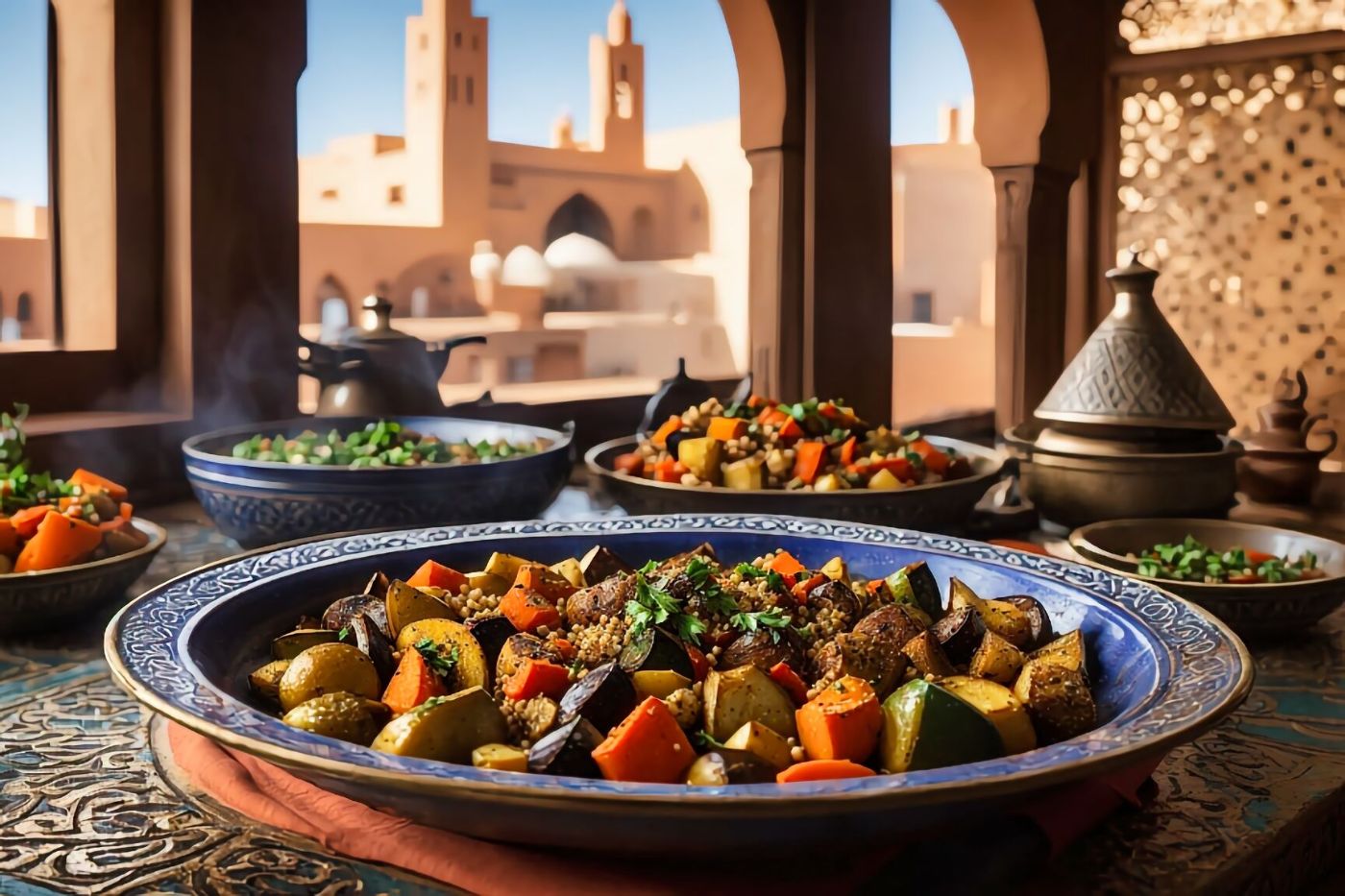
Roasted Moroccan-Style Vegetables is a flavorful dish featuring an assortment of vegetables seasoned with traditional Moroccan spices. Vegetables like carrots, bell peppers, zucchini, and eggplant are tossed with a mixture of cumin, paprika, turmeric, and cinnamon. The vegetables are then roasted until tender and caramelized, resulting in a delicious medley of flavors. This dish can be served as a side dish or as a main course with couscous or crusty bread. It’s a vibrant and nutritious option that showcases the aromatic and bold flavors of Moroccan cuisine.
16. Moroccan Chicken Couscous Bowl
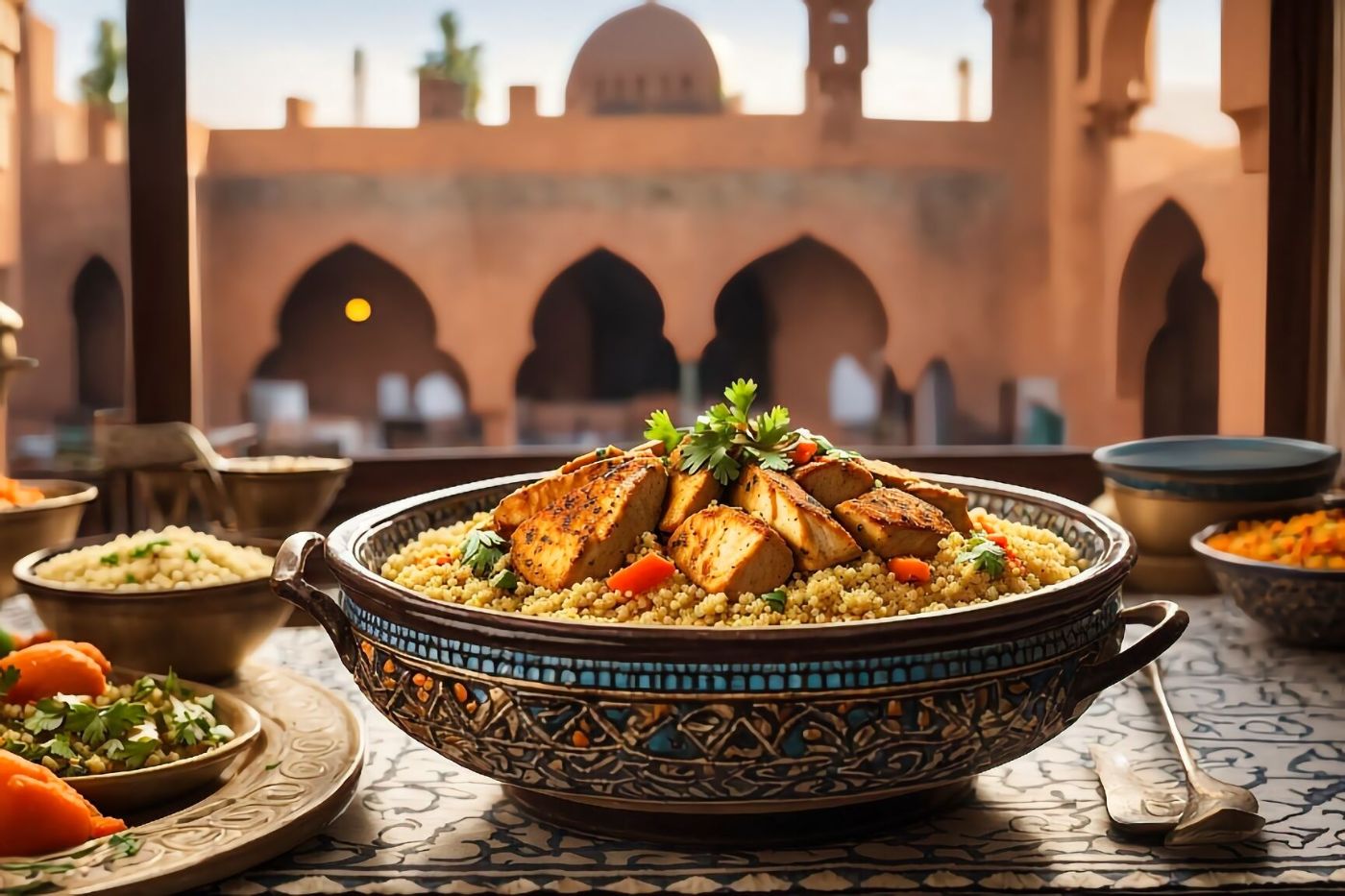
Moroccan Chicken Couscous Bowl is a hearty and flavorful dish that combines tender chicken, aromatic spices, and fluffy couscous. The chicken is seasoned with a blend of Moroccan spices like cumin, coriander, and paprika, then cooked until juicy and flavorful. Served over a bed of fluffy couscous, it’s topped with a medley of roasted vegetables, such as carrots, zucchini, and bell peppers. This vibrant and satisfying bowl is finished with a drizzle of tangy yogurt sauce and a sprinkle of fresh herbs. It’s a complete and nutritious meal that showcases the delicious flavors of Moroccan cuisine.
17. Moroccan-Style Lamb Shanks
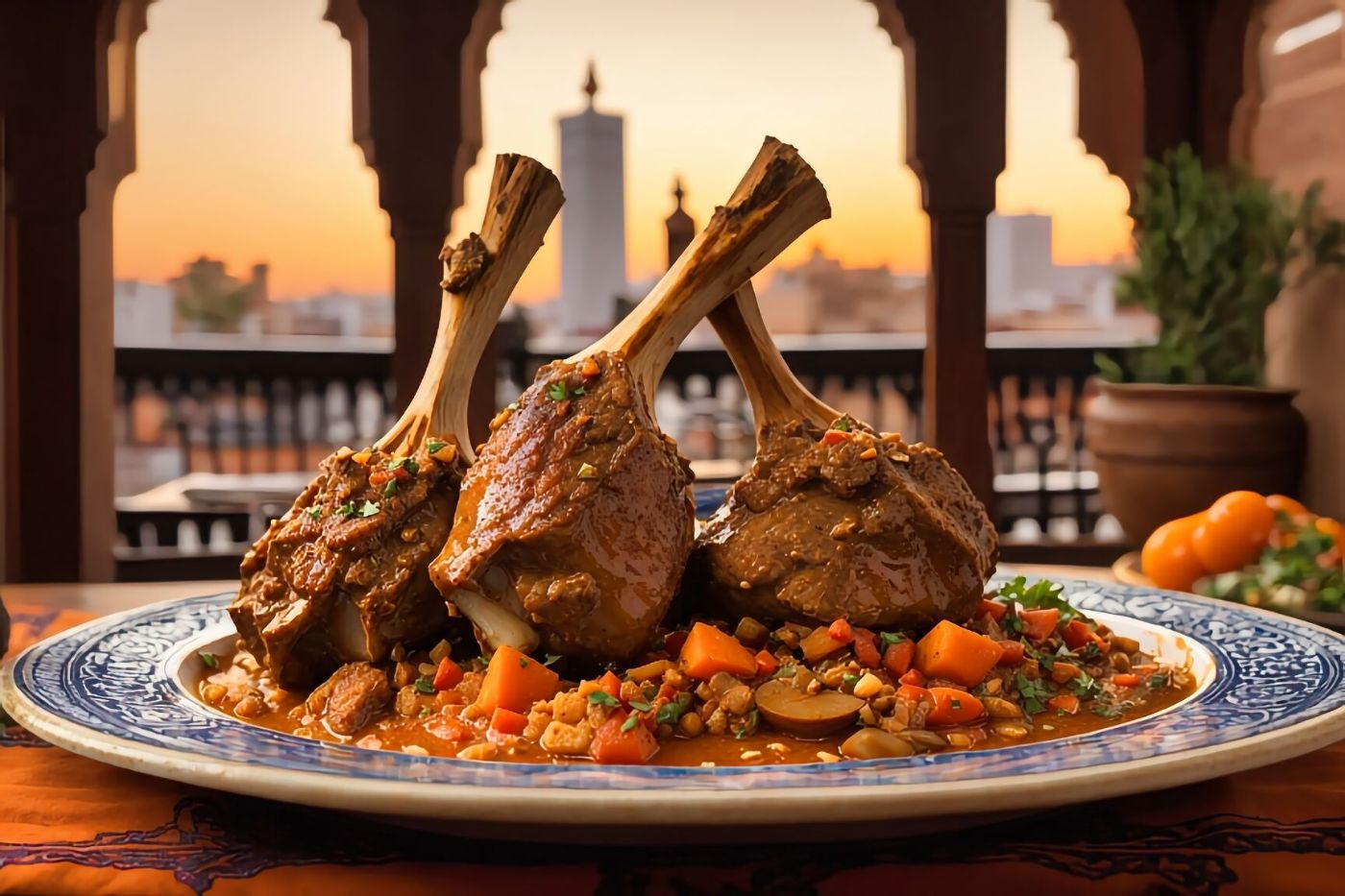
Moroccan-Style Lamb Shanks is a succulent and aromatic dish that showcases the rich flavors of Moroccan cuisine. The lamb shanks are marinated in a blend of spices including cumin, coriander, cinnamon, and ginger, then slow-cooked until tender and falling off the bone. The dish is traditionally prepared with a combination of onions, garlic, tomatoes, and a touch of honey or dried fruits for a subtle sweetness. The flavors are further enhanced with a hint of saffron and a garnish of fresh herbs like cilantro or parsley. It’s a comforting and satisfying meal that pairs perfectly with couscous or rice.
18. Quick Moroccan Shrimp Skillet
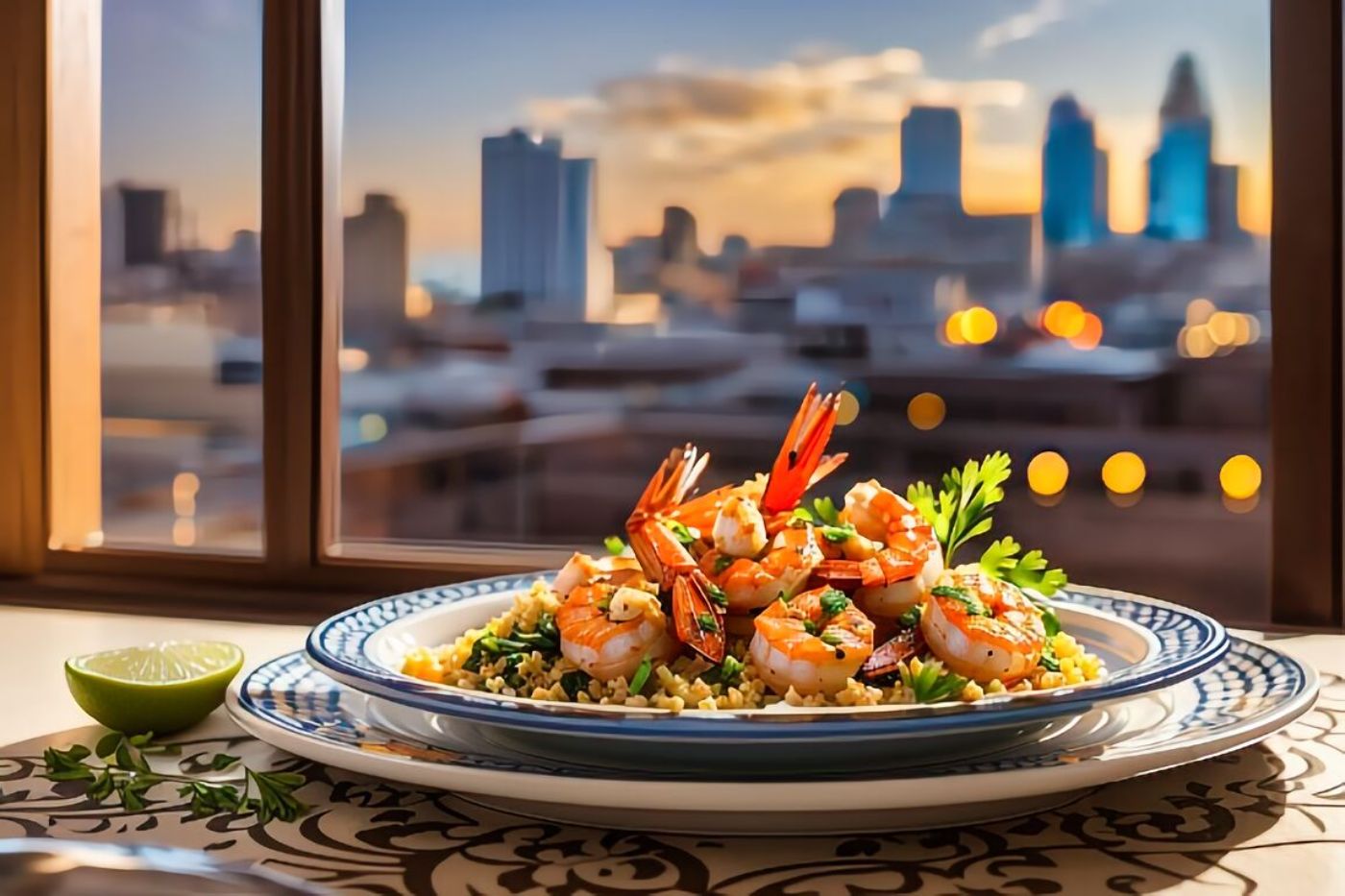
Quick Moroccan Shrimp Skillet is a flavorful and easy-to-make dish that captures the essence of Moroccan cuisine. The dish features succulent shrimp cooked in a fragrant blend of spices such as cumin, paprika, turmeric, and cinnamon. It is complemented with the vibrant flavors of garlic, ginger, and lemon zest. The skillet also includes a medley of colorful vegetables like bell peppers, tomatoes, and onions, adding freshness and texture to the dish. It is a delightful and satisfying meal that can be served with couscous or crusty bread for a complete Moroccan experience.
19. Moroccan Chicken Tagine Pockets
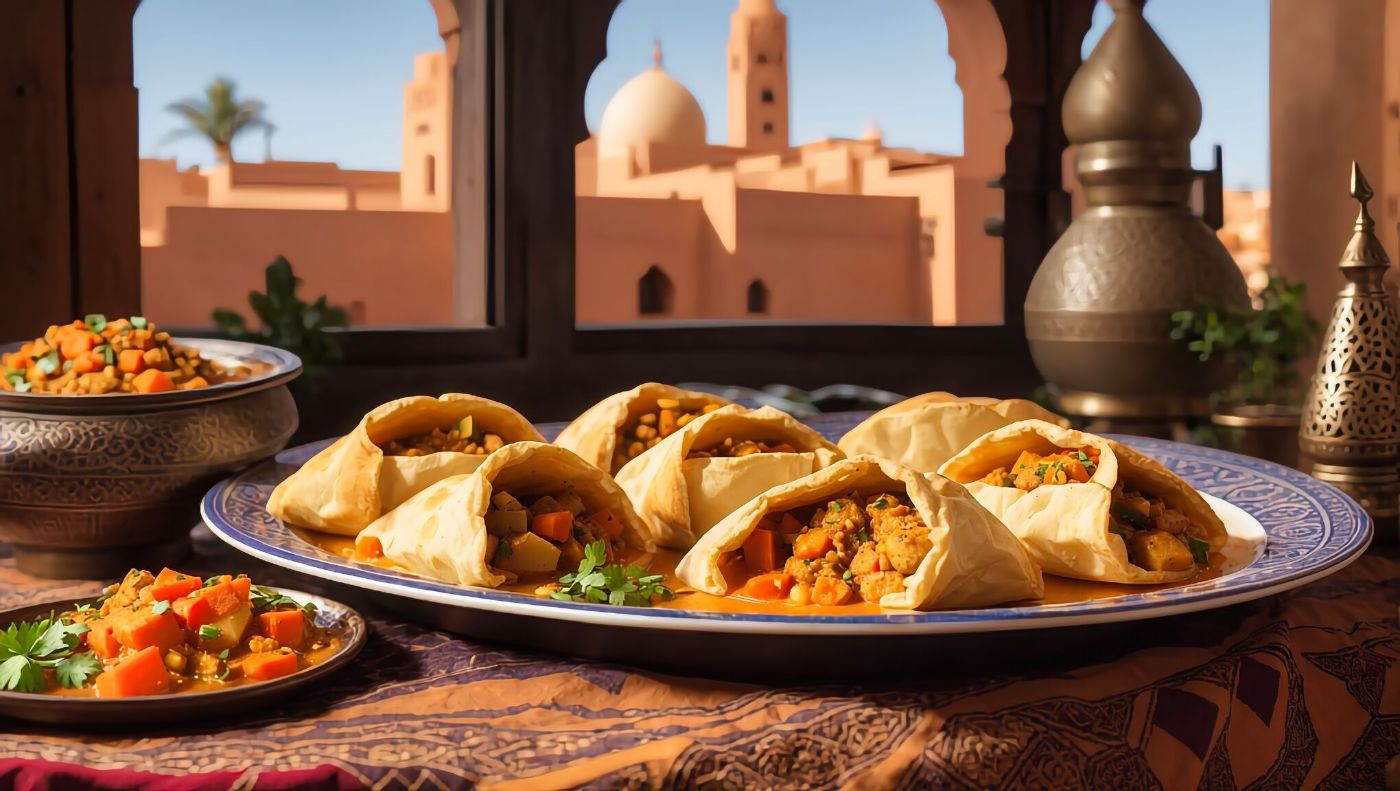
Moroccan Chicken Tagine Pockets are a delicious and portable version of the classic Moroccan dish. Tender chicken is marinated in a flavorful blend of Moroccan spices such as cumin, coriander, and cinnamon, then cooked with onions, tomatoes, and olives. The filling is wrapped in puff pastry and baked until golden and flaky. These pockets are perfect for a quick and satisfying meal or as a party appetizer. The combination of aromatic spices and savory chicken creates a delightful Moroccan flavor experience in every bite.
20. Iced Melon Moroccan Mint Tea
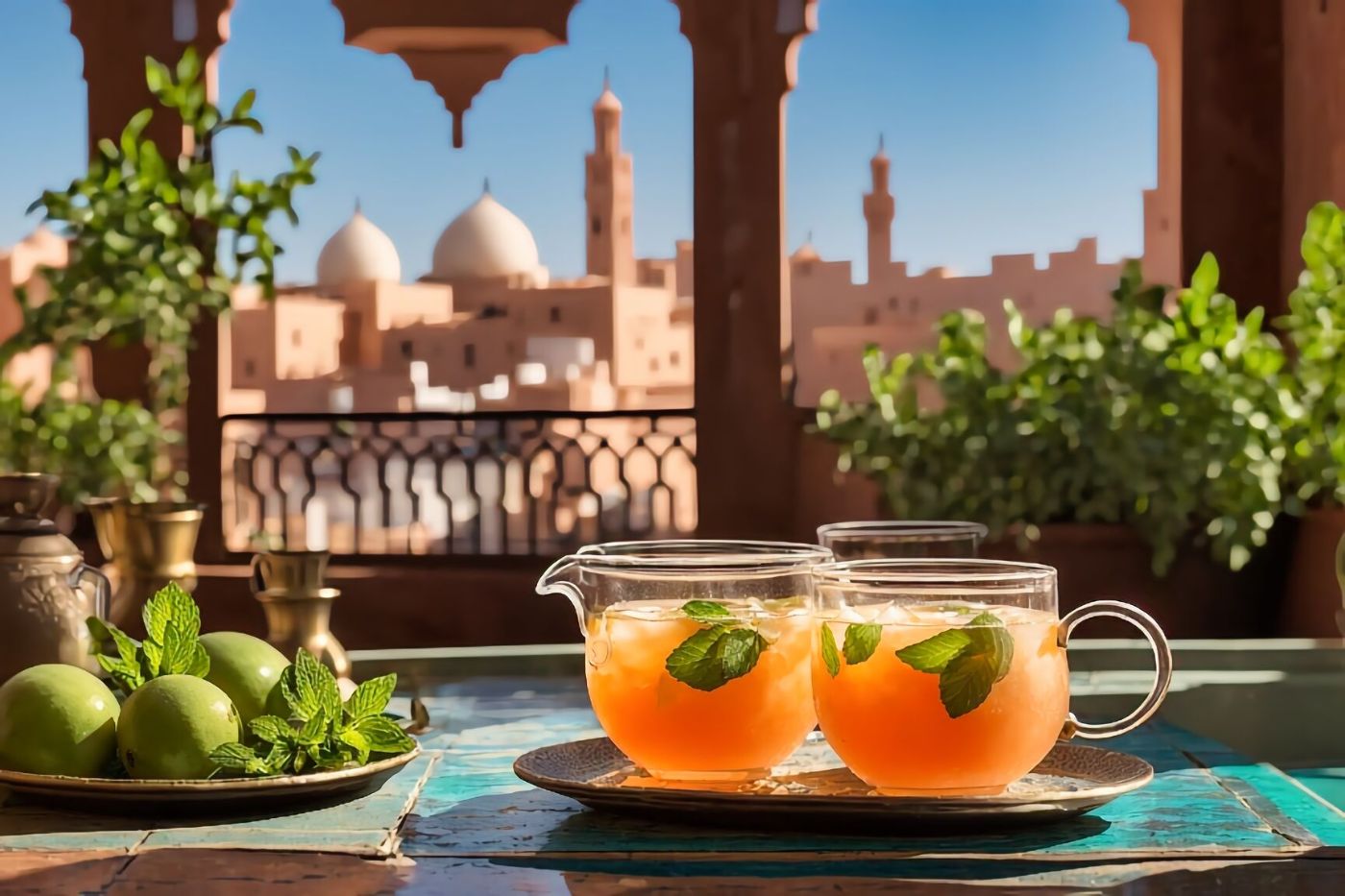
Iced Melon Moroccan Mint Tea is a refreshing and flavorful drink perfect for hot summer days. Fresh melon, such as watermelon or cantaloupe, is blended with Moroccan mint leaves and steeped in hot water to create a fragrant and fruity tea base. The tea is then chilled and served over ice, garnished with fresh mint leaves and a squeeze of lemon for added brightness. The combination of the sweet melon, cooling mint, and tangy lemon creates a delightful balance of flavors that will quench your thirst and provide a cooling sensation. Enjoy this Moroccan-inspired iced tea as a refreshing beverage any time of the day.
21. Moroccan Stuffed Mushrooms
